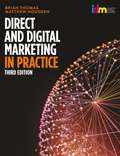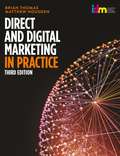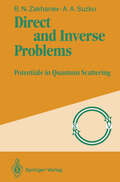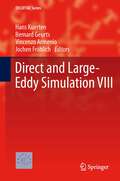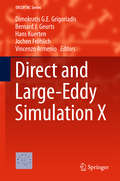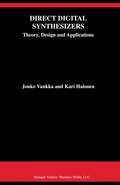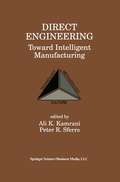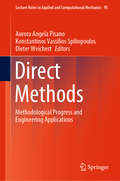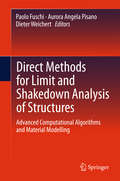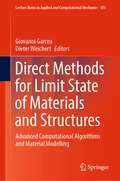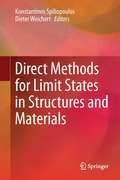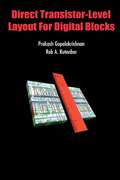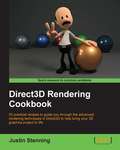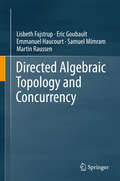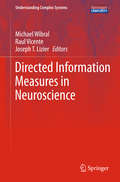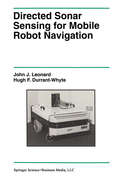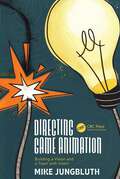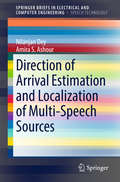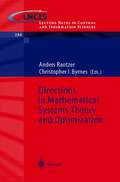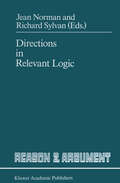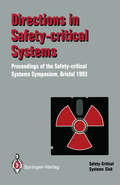- Table View
- List View
Direct and Digital Marketing in Practice
by Brian Thomas Matthew HousdenDirect and Digital Marketing in Practice is the essential manual for all managers, marketers and students. Incisive and thorough, the text has been fully updated to reflect the continuing impact and future implications of the Internet on marketing. This new 3rd edition is one of the only comprehensive textbooks written entirely by current practising professionals. It explains in detail the powerful offline and online techniques available to direct marketers today. Direct and Digital Marketing in Practice covers vital issues such as: · the new marketing landscape; · gaining customer insight; · maximising returns on marketing investment;· integrating traditional and digital media; · campaign planning and budgeting;· offline and online metrics:· testing and statistics; and· developing compelling propositions.Direct and Digital Marketing in Practice is an ideal reference tool, presenting detailed explanations of key concepts with practical examples and case studies. The book ensures that each point is relevant and memorable, and made in a real-world context. Written for managers looking to expand and enhance customer reach, students on MBA courses, and those taking professional qualifications, the book provides an invaluable and up-to-date guide to marketing best theory and practice in our increasingly digital and online age.
Direct and Digital Marketing in Practice (PDF)
by Brian Thomas Matthew HousdenDirect and Digital Marketing in Practice is the essential manual for all managers, marketers and students. Incisive and thorough, the text has been fully updated to reflect the continuing impact and future implications of the Internet on marketing. This new 3rd edition is one of the only comprehensive textbooks written entirely by current practising professionals. It explains in detail the powerful offline and online techniques available to direct marketers today. Direct and Digital Marketing in Practice covers vital issues such as: · the new marketing landscape; · gaining customer insight; · maximising returns on marketing investment;· integrating traditional and digital media; · campaign planning and budgeting;· offline and online metrics:· testing and statistics; and· developing compelling propositions.Direct and Digital Marketing in Practice is an ideal reference tool, presenting detailed explanations of key concepts with practical examples and case studies. The book ensures that each point is relevant and memorable, and made in a real-world context. Written for managers looking to expand and enhance customer reach, students on MBA courses, and those taking professional qualifications, the book provides an invaluable and up-to-date guide to marketing best theory and practice in our increasingly digital and online age.
Direct and Inverse Problems: Potentials in Quantum Scattering
by Boris N. Zakhariev Allina A. SuzkoRapid progress in quantum theory brings us new important results which are often not immediately clear to all who need them. But fortunately, this is also followed by simplifications and unifications of our previous concepts. The inverse problem method ("The most beautiful idea of the XX-th century" - Zakharov et aI., 1980) has just both these aspects. It is rather astonishing that it took 50 years after the foundation of quantum mechanics for the creation of the "pictures" showing the direct connection of obser vables with interactions. Recently, illustrations of this type began to appear in the literature (e. g., how potentials are deformed with thc shift of one energy level or change of some resonance reduced width). Although they are transparent to those studying the quantum world and can be included within the necessary elements of quantum literacy, they are still largely unknown even to many specialists. For the first time, the most interesting of these pictures enriching our quantum intuition are col lected here and placed at your disposal. The readers of this monograph have the advantage of getting the latest information which became available after the publication of the Russian edition. It has been incor porated here in the simplest presentation possible. For example, new sections con cerning exactly solvable models, including the multi-channel, multi-dimensional ones and with time dependent potentials have been added. The first attempts in solving the three-body inverse problem are also mentioned.
Direct and Large-Eddy Simulation VIII (ERCOFTAC Series #15)
by Bernard Geurts Vincenzo Armenio Jochen Öhlich Hans KuertenThis volume continues previous DLES proceedings books, presenting modern developments in turbulent flow research. It is comprehensive in its coverage of numerical and modeling techniques for fluid mechanics.After Surrey in 1994, Grenoble in 1996, Cambridge in 1999, Enschede in 2001, Munich in 2003, Poitiers in 2005, and Trieste in 2009, the 8th workshop, DLES8, was held in Eindhoven, The Netherlands, again under the auspices of ERCOFTAC. Following the spirit of the series, the goal of this workshop is to establish a state-of-the-art of DNS and LES techniques for the computation and modeling of transitional/turbulent flows covering a broad scope of topics such as aerodynamics, acoustics, combustion, multiphase flows, environment, geophysics and bio-medical applications. This gathering of specialists in the field was a unique opportunity for discussions about the more recent advances in the prediction, understanding and control of turbulent flows in academic or industrial situations.
Direct and Large-Eddy Simulation X (ERCOFTAC Series #24)
by Dimokratis G.E. Grigoriadis Bernard J. Geurts Hans Kuerten Jochen Fröhlich Vincenzo ArmenioThis book addresses nearly all aspects of the state of the art in LES & DNS of turbulent flows, ranging from flows in biological systems and the environment to external aerodynamics, domestic and centralized energy production, combustion, propulsion as well as applications of industrial interest. Following the advances in increased computational power and efficiency, several contributions are devoted to LES & DNS of challenging applications, mainly in the area of turbomachinery, including flame modeling, combustion processes and aeroacoustics.The book includes work presented at the tenth Workshop on 'Direct and Large-Eddy Simulation' (DLES-10), which was hosted in Cyprus by the University of Cyprus, from May 27 to 29, 2015. The goal of the workshop was to establish a state of the art in DNS, LES and related techniques for the computation and modeling of turbulent and transitional flows. The book is of interest to scientists and engineers, both in the early stages of their career and at a more senior level.
Direct Digital Synthesizers: Theory, Design and Applications (The Springer International Series in Engineering and Computer Science #614)
by Jouko Vankka Kari A.I. HalonenA major advantage of a direct digital synthesizer is that its output frequency, phase and amplitude can be precisely and rapidly manipulated under digital processor control. This book was written to find possible applications for radio communication systems.
Direct Engineering: Toward Intelligent Manufacturing
by Ali K. Kamrani Peter R. SferroDirect Engineering (DE) is the creation of a product development cycle into a single, unified process. The design process in most industries is an evolutionary one (i.e., incremental changes to some existing design). DE is a manufacturing process that seeks to improve the design processes by providing complete archival documentation of existing designs. It uses three-dimensional geometric models with integrated manufacturing information throughout the design process. DE reduces the design cycle, and the variety and number of engineering changes. This process decreases the design cycle time, increases productivity, and provides a higher quality product. The required technologies and methodologies that will support the development of the DE environment are: (1) product representation using feature-based modeling; (2) knowledge-based applications that will support the entire product development cycle; (3) an engineering environment implemented around distributed computing and object-oriented systems; (4) direct manufacturing techniques using rapid prototyping. Direct Engineering: Toward Intelligent Manufacturing addresses the following recent topics related to the development, implementation, and integration of the DE environment: (1) the current scope of the research in intelligent manufacturing; (2) the results of the technologies and tools developed for integrated product and process designs, and (3) examination of the methodologies and algorithms used for the implementation of direct engineering.
Direct, Indirect and Index Register Addressing (tactile)
by RnibThis diagram shows 3 diagrams over 3 pages showing direct, indirect and index register addressing. Page 1 shows direct addressing and shows an arrow from a box labelled operand to data within a box labelled memory. Page 2 show indirect addressing an arrow moving from the operand to an address and then to data within the memory. Page 3 shows lines moving from boxes labelled operand and index register to a circle labelled +. Then moving onto data within the memory.
Direct Methods: Methodological Progress and Engineering Applications (Lecture Notes in Applied and Computational Mechanics #95)
by Aurora Angela Pisano Konstantinos Vassilios Spiliopoulos Dieter WeichertThis book provides an overview of direct methods such as limit and shakedown analysis, which are intended to do away with the need for cumbersome step-by-step calculations and determine the loading limits of mechanical structures under monotone, cyclic or variable loading with unknown loading history. The respective contributions demonstrate how tremendous advances in numerical methods, especially in optimization, have contributed to the success of direct methods and their practical applicability to engineering problems in structural mechanics, pavement and general soil mechanics, as well as the design of composite materials. The content reflects the outcomes of the workshop “Direct Methods: Methodological Progress and Engineering Applications,” which was offered as a mini-symposium of PCM-CMM 2019, held in Cracow, Poland in September 2019.
Direct Methods for Limit and Shakedown Analysis of Structures: Advanced Computational Algorithms and Material Modelling (Solid Mechanics and Its Applications #220)
by Paolo Fuschi Aurora Angela Pisano Dieter WeichertArticles in this book examine various materials and how to determine directly the limit state of a structure, in the sense of limit analysis and shakedown analysis. Apart from classical applications in mechanical and civil engineering contexts, the book reports on the emerging field of material design beyond the elastic limit, which has further industrial design and technological applications. Readers will discover that “Direct Methods” and the techniques presented here can in fact be used to numerically estimate the strength of structured materials such as composites or nano-materials, which represent fruitful fields of future applications.Leading researchers outline the latest computational tools and optimization techniques and explore the possibility of obtaining information on the limit state of a structure whose post-elastic loading path and constitutive behavior are not well defined or well known. Readers will discover how Direct Methods allow rapid and direct access to requested information in mathematically constructive manners without cumbersome step-by-step computation.Both researchers already interested or involved in the field and practical engineers who want to have a panorama of modern methods for structural safety assessment will find this book valuable. It provides the reader with the latest developments and a significant amount of references on the topic.
Direct Methods for Limit State of Materials and Structures: Advanced Computational Algorithms and Material Modelling (Lecture Notes in Applied and Computational Mechanics #101)
by Giovanni Garcea Dieter WeichertThis book provides an overview of direct methods, such as limit and shakedown analysis, which are intended for avoiding cumbersome step-by-step calculations to determine the limit states of mechanical structures under monotone, cyclic or variable actions with unknown loading history. The book comprises several contributions that demonstrate how tremendous advances in numerical methods, especially in optimization, have contributed to the success of direct methods and their applicability to practical engineering problems in structural mechanics and mechanics of materials. The contents reflect the outcomes of the workshop “Direct Methods for Limit State of Materials and Structures,” held in Cosenza, Italy in June 2022.
Direct Methods for Limit States in Structures and Materials
by Konstantinos Spiliopoulos Dieter WeichertKnowing the safety factor for limit states such as plastic collapse, low cycle fatigue or ratcheting is always a major design consideration for civil and mechanical engineering structures that are subjected to loads. Direct methods of limit or shakedown analysis that proceed to directly find the limit states offer a better alternative than exact time-stepping calculations as, on one hand, an exact loading history is scarcely known, and on the other they are much less time-consuming. This book presents the state of the art on various topics concerning these methods, such as theoretical advances in limit and shakedown analysis, the development of relevant algorithms and computational procedures, sophisticated modeling of inelastic material behavior like hardening, non-associated flow rules, material damage and fatigue, contact and friction, homogenization and composites.
Direct Transistor-Level Layout for Digital Blocks
by Prakash Gopalakrishnan Rob A. RutenbarCell-based design methodologies have dominated layout generation of digital circuits. Unfortunately, the growing demands for transparent process portability, increased performance, and low-level device sizing for timing/power are poorly handled in a fixed cell library. Direct Transistor-Level Layout For Digital Blocks proposes a direct transistor-level layout approach for small blocks of custom digital logic as an alternative that better accommodates demands for device-level flexibility. This approach captures essential shape-level optimizations, yet scales easily to netlists with thousands of devices, and incorporates timing optimization during layout. The key idea is early identification of essential diffusion-merged MOS device groups, and their preservation in an uncommitted geometric form until the very end of detailed placement. Roughly speaking, essential groups are extracted early from the transistor-level netlist, placed globally, optimized locally, and then finally committed each to a specific shape-level form while concurrently optimizing for both density and routability. The essential flaw in prior efforts is an over-reliance on geometric assumptions from large-scale cell-based layout algorithms. Individual transistors may seem simple, but they do not pack as gates do. Algorithms that ignore these shape-level issues suffer the consequences when thousands of devices are poorly packed. The approach described in this book can pack devices much more densely than a typical cell-based layout.Direct Transistor-Level Layout For Digital Blocks is a comprehensive reference work on device-level layout optimization, which will be valuable to CAD tool and circuit designers.
Direct3D Rendering Cookbook
by Justin StenningThis is a practical cookbook that dives into the various methods of programming graphics with a focus on games. It is a perfect package of all the innovative and up-to-date 3D rendering techniques supported by numerous illustrations, strong sample code, and concise explanations. Direct3D Rendering Cookbook is for C# .NET developers who want to learn the advanced rendering techniques made possible with DirectX 11.2. It is expected that the reader has at least a cursory knowledge of graphics programming, and although some knowledge of Direct3D 10+ is helpful, it is not necessary. An understanding of vector and matrix algebra is required.
Directed Algebraic Topology and Concurrency (SpringerBriefs in Applied Sciences and Technology)
by Lisbeth Fajstrup Eric Goubault Emmanuel Haucourt Samuel Mimram Martin RaussenThis monograph presents an application of concepts and methods from algebraic topology to models of concurrent processes in computer science and their analysis.Taking well-known discrete models for concurrent processes in resource management as a point of departure, the book goes on to refine combinatorial and topological models. In the process, it develops tools and invariants for the new discipline directed algebraic topology, which is driven by fundamental research interests as well as by applications, primarily in the static analysis of concurrent programs.The state space of a concurrent program is described as a higher-dimensional space, the topology of which encodes the essential properties of the system. In order to analyse all possible executions in the state space, more than “just” the topological properties have to be considered: Execution paths need to respect a partial order given by the time flow. As a result, tools and concepts from topology have to be extended to take privileged directions into account.The target audience for this book consists of graduate students, researchers and practitioners in the field, mathematicians and computer scientists alike.
Directed Information Measures in Neuroscience (Understanding Complex Systems)
by Michael Wibral Raul Vicente Joseph T. LizierAnalysis of information transfer has found rapid adoption in neuroscience, where a highly dynamic transfer of information continuously runs on top of the brain's slowly-changing anatomical connectivity. Measuring such transfer is crucial to understanding how flexible information routing and processing give rise to higher cognitive function. Directed Information Measures in Neuroscience reviews recent developments of concepts and tools for measuring information transfer, their application to neurophysiological recordings and analysis of interactions. Written by the most active researchers in the field the book discusses the state of the art, future prospects and challenges on the way to an efficient assessment of neuronal information transfer. Highlights include the theoretical quantification and practical estimation of information transfer, description of transfer locally in space and time, multivariate directed measures, information decomposition among a set of stimulus/responses variables and the relation between interventional and observational causality. Applications to neural data sets and pointers to open source software highlight the usefulness of these measures in experimental neuroscience. With state-of-the-art mathematical developments, computational techniques and applications to real data sets, this book will be of benefit to all graduate students and researchers interested in detecting and understanding the information transfer between components of complex systems.
Directed Sonar Sensing for Mobile Robot Navigation (The Springer International Series in Engineering and Computer Science #175)
by John J. Leonard Hugh F. Durrant-WhyteThis monograph is a revised version of the D.Phil. thesis of the first author, submitted in October 1990 to the University of Oxford. This work investigates the problem of mobile robot navigation using sonar. We view model-based navigation as a process of tracking naturally occurring environment features, which we refer to as "targets". Targets that have been predicted from the environment map are tracked to provide that are observed, but not predicted, vehicle position estimates. Targets represent unknown environment features or obstacles, and cause new tracks to be initiated, classified, and ultimately integrated into the map. Chapter 1 presents a brief definition of the problem and a discussion of the basic research issues involved. No attempt is made to survey ex haustively the mobile robot navigation literature-the reader is strongly encouraged to consult other sources. The recent collection edited by Cox and Wilfong [34] is an excellent starting point, as it contains many of the standard works of the field. Also, we assume familiarity with the Kalman filter. There are many well-known texts on the subject; our notation derives from Bar-Shalom and Fortmann [7]. Chapter 2 provides a detailed sonar sensor model. A good sensor model of our approach to navigation, and is used both for is a crucial component predicting expected observations and classifying unexpected observations.
Directing Game Animation: Building a Vision and a Team with Intent
by Mike JungbluthThe best character animation has a strong creative intent, driving a compelling performance. With the addition of interactivity, game animation adds complexity to the craft of how best to balance art, design and technology to realize a character’s performance. As a director, you are responsible for not only defining a vision for how those should balance but also being a leader, mentor and advocate for your team. But in a field of rapid iteration of ideas and techniques, that strong creative intent can be easily lost or sacrificed if not properly fostered and defined.Directing Game Animation: Building a Vision and a Team with Intent breaks down the process of creating an intentional animation vision that can be both unique and flexible. From defining the high-level experience to breaking down tech needs, projecting a team size and empowering everyone to work together, this book will help you to wrap your mind around a project’s animation needs.Animation, like every part of a game, cannot succeed—let alone function—in a vacuum. This book looks to foster a discussion around the process, needs and benefits of an empowered animation team and its vision as a universal benefit for the entire industry.This book is a guide to answer some of the most common questions people encounter when engaging with the overlap between creative and project leadership. What is your role? Learn how to establish expectations and needs specific to the project and team. How do you establish a vision? Learn how to better define and communicate creative topics such as a cohesive character performance and animation style. How do you build a team? Learn how to establish early on the team structure, skills and workflows needed to deliver on the needs of the project. How do you balance creative and production needs? Learn how to define quality, reviews and approvals in a way that empowers creativity and decision-making.
Directing Game Animation: Building a Vision and a Team with Intent
by Mike JungbluthThe best character animation has a strong creative intent, driving a compelling performance. With the addition of interactivity, game animation adds complexity to the craft of how best to balance art, design and technology to realize a character’s performance. As a director, you are responsible for not only defining a vision for how those should balance but also being a leader, mentor and advocate for your team. But in a field of rapid iteration of ideas and techniques, that strong creative intent can be easily lost or sacrificed if not properly fostered and defined.Directing Game Animation: Building a Vision and a Team with Intent breaks down the process of creating an intentional animation vision that can be both unique and flexible. From defining the high-level experience to breaking down tech needs, projecting a team size and empowering everyone to work together, this book will help you to wrap your mind around a project’s animation needs.Animation, like every part of a game, cannot succeed—let alone function—in a vacuum. This book looks to foster a discussion around the process, needs and benefits of an empowered animation team and its vision as a universal benefit for the entire industry.This book is a guide to answer some of the most common questions people encounter when engaging with the overlap between creative and project leadership. What is your role? Learn how to establish expectations and needs specific to the project and team. How do you establish a vision? Learn how to better define and communicate creative topics such as a cohesive character performance and animation style. How do you build a team? Learn how to establish early on the team structure, skills and workflows needed to deliver on the needs of the project. How do you balance creative and production needs? Learn how to define quality, reviews and approvals in a way that empowers creativity and decision-making.
Directing the Story: Professional Storytelling and Storyboarding Techniques for Live Action and Animation
by Francis GlebasFrancis Glebas, a top Disney storyboard artist, shows how to reach the ultimate goal of animation and moviemaking by showing how to provide audiences with an emotionally satisfying experience. Directing the Story offers a structural approach to clearly and dramatically presenting visual stories. With Francis' help you'll discover the professional storytelling techniques which have swept away generations of movie goers and kept them coming back for more. You'll also learn to spot potential problems before they cost you time or money and offers creative solutions to solve them.Best of all, it practices what it preaches, using a graphic novel format to demonstrate the professional visual storytelling techniques you need to know.
Directing the Story: Professional Storytelling and Storyboarding Techniques for Live Action and Animation
by Francis GlebasFrancis Glebas, a top Disney storyboard artist, shows how to reach the ultimate goal of animation and moviemaking by showing how to provide audiences with an emotionally satisfying experience. Directing the Story offers a structural approach to clearly and dramatically presenting visual stories. With Francis' help you'll discover the professional storytelling techniques which have swept away generations of movie goers and kept them coming back for more. You'll also learn to spot potential problems before they cost you time or money and offers creative solutions to solve them.Best of all, it practices what it preaches, using a graphic novel format to demonstrate the professional visual storytelling techniques you need to know.
Direction of Arrival Estimation and Localization of Multi-Speech Sources (SpringerBriefs in Speech Technology)
by Nilanjan Dey Amira S. AshourThis book presents research and applications on arrival estimation and localization in speech processing to ensure that the broad vision of the direction of arrival estimation (DOAE) / localization of speech sources is well-established. The book first provides a brief overview of the most classical direction of arrival estimation and localization techniques. It then introduces the concept and model of acoustics sources and then highlights the most contemporary studies on this pervasive problem. In addition, the authors explore employing the optimization algorithms to improve the DOAE techniques. The book then highlights the concept and principles of the multi-DOAE approaches. Using a microphone array, the book introduces the localization and tracking problem of multiple speech/acoustic sources. It includes several applications and real-life speech sources localization based on the DOAE approaches. The book reports the challenges facing the DOAE techniques in speech-sources localization. The book pertains to researchers, designers, and engineers in speech processing fields.
Directions in Mathematical Systems Theory and Optimization (Lecture Notes in Control and Information Sciences #286)
by Anders Rantzer Christopher I. ByrnesFor more than three decades, Anders Lindquist has delivered fundamental cont- butions to the ?elds of systems, signals and control. Throughout this period, four themes can perhaps characterize his interests: Modeling, estimation and ?ltering, feedback and robust control. His contributions to modeling include seminal work on the role of splitting subspaces in stochastic realization theory, on the partial realization problem for both deterministic and stochastic systems, on the solution of the rational covariance extension problem and on system identi?cation. His contributions to ?ltering and estimation include the development of fast ?ltering algorithms, leading to a nonlinear dynamical system which computes spectral factors in its steady state, and which provide an alternate, linear in the dimension of the state space, to computing the Kalman gain from a matrix Riccati equation. His further research on the phase portrait of this dynamical system gave a better understanding of when the Kalman ?lter will converge, answering an open question raised by Kalman. While still a student he established the separation principle for stochastic function differential equations, including some fundamental work on optimal control for stochastic systems with time lags. He continued his interest in feedback control by deriving optimal and robust control feedback laws for suppressing the effects of harmonic disturbances. Moreover, his recent work on a complete parameterization of all rational solutions to the Nevanlinna-Pick problem is providing a new approach to robust control design.
Directions in Relevant Logic (Reason and Argument #1)
by J. Norman R. SylvanRelevance logics came of age with the one and only International Conference on relevant logics in 1974. They did not however become accepted, or easy to promulgate. In March 1981 we received most of the typescript of IN MEMORIAM: ALAN ROSS ANDERSON Proceedings of the International Conference of Relevant Logic from the original editors, Kenneth W. Collier, Ann Gasper and Robert G. Wolf of Southern Illinois University. 1 They had, most unfortunately, failed to find a publisher - not, it appears, because of overall lack of merit of the essays, but because of the expense of producing the collection, lack of institutional subsidization, and doubts of publishers as to whether an expensive collection of essays on such an esoteric, not to say deviant, subject would sell. We thought that the collection of essays was still (even after more than six years in the publishing trade limbo) well worth publishing, that the subject would remain undeservedly esoteric in North America while work on it could not find publishers (it is not so esoteric in academic circles in Continental Europe, Latin America and the Antipodes) and, quite important, that we could get the collection published, and furthermore, by resorting to local means, published comparatively cheaply. It is indeed no ordinary collection. It contains work by pioneers of the main types of broadly relevant systems, and by several of the most innovative non-classical logicians of the present flourishing logical period. We have slowly re-edited and reorganised the collection and made it camera-ready.
Directions in Safety-Critical Systems: Proceedings of the First Safety-critical Systems Symposium The Watershed Media Centre, Bristol 9–11 February 1993
by Felix Redmill Tom Anderson0 e This is the proceedings of the first annual symposium of the Safety-critical Systems Club (The Watershed Media Centre, Bristol, 9-11 February 1993), which provided a forum for exploring and discussing ways of achieving safety in computer systems to be used in safety-critical industrial applications. The book is divided into three parts, which correspond with the themes of the three days of the symposium. The first - Experience from Around Europe - brings together information on developments in safety-critical systems outside the UK. The second - Current Research - consists of papers on large projects within the UK, which involve collaboration between academia and industry, providing techniques and methods to enhance safety. The final part - Achieving and Evaluating Safety - explores how methods already in use in other domains may be applied to safety, and examines the relationships between safety and other attributes such as quality and security. The papers identify the current problems and issues of interest in the field of safety-critical software-based systems, and provide valuable up-to-date material for those in both academia and industry. The academic will benefit from information about current research complimentary to his own, and the industrialist will learn of the technologies which will soon be available and where to find them.
